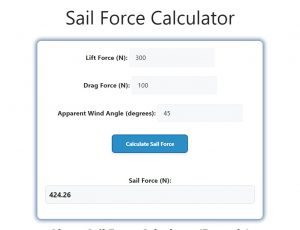About Sail Force Calculator (Formula)
Sailing relies heavily on understanding the forces acting on a sail. Calculating sail force is crucial for optimizing speed, direction, and efficiency. The sail force depends on factors like lift, drag, and the angle of attack, which together influence how a sailboat moves. This article will cover the formula for sail force, explain how to use the sail force calculator, and answer common questions about sail force calculations.
Formula
The formula for calculating sail force (SF) is:
Sail Force = [Lift × sine(angle of attack) – Drag × cosine(angle of attack)] + [Lift × cosine(angle of attack) + Drag × sine(angle of attack)]
Where:
- SF is the sail force.
- Lift (L) is the aerodynamic force perpendicular to the relative wind.
- Drag (D) is the aerodynamic force parallel to the relative wind.
- Angle of attack (a) is the angle between the wind direction and the sail.
How to Use
- Input the lift (L) value, which is based on the wind speed and sail characteristics.
- Input the drag (D) value, which is influenced by the sail’s shape and the wind’s resistance.
- Determine the angle of attack (a) between the sail and the wind direction.
- The calculator will compute the total sail force (SF) based on these inputs.
Example
Let’s say you have the following inputs:
- Lift (L) = 300 N
- Drag (D) = 100 N
- Angle of attack (a) = 45 degrees
Using the formula:
Sail Force = [300 × sine(45°) – 100 × cosine(45°)] + [300 × cosine(45°) + 100 × sine(45°)]
Sail Force = 141.42 N + 282.84 N
Sail Force = 424.26 N 
FAQs
- What is sail force?
Sail force is the combined effect of aerodynamic forces acting on a sail, helping propel the boat forward or change its direction. - What is lift in sailing?
Lift is the force that acts perpendicular to the wind direction and helps move the sailboat in the intended direction. - What is drag in sailing?
Drag is the aerodynamic resistance caused by the wind hitting the sail, which opposes the boat’s forward movement. - What is the angle of attack?
The angle of attack refers to the angle between the sail and the wind direction. It affects both lift and drag. - How does the angle of attack affect sail force?
A higher angle of attack increases both lift and drag, which in turn affects the overall sail force and speed of the boat. - Why do I need to calculate sail force?
Calculating sail force helps optimize sailing performance by adjusting sail settings for maximum speed, control, and efficiency. - What units are used in sail force calculations?
Sail force is usually measured in newtons (N), while angle of attack is measured in degrees. - How do lift and drag impact sailboat speed?
Lift helps propel the boat forward, while drag slows it down. Optimizing the balance between the two is key to achieving the desired speed. - Can I use this formula for any type of sailboat?
Yes, the formula applies to different types of sailboats, but you need accurate values for lift, drag, and angle of attack specific to your setup. - What factors affect lift and drag?
Wind speed, sail shape, sail material, and boat direction are primary factors that influence lift and drag. - How do I measure lift and drag?
Lift and drag can be measured using wind tunnel tests or calculated based on sail dimensions, wind speed, and other aerodynamic properties. - Does wind speed affect sail force?
Yes, wind speed directly influences both lift and drag, and therefore affects the sail force generated. - Can sail force help in controlling the direction of the boat?
Yes, adjusting the sail force by changing the sail angle helps in steering and controlling the boat’s direction. - How can I reduce drag on a sailboat?
Reducing drag involves optimizing the sail’s angle of attack and using materials that reduce wind resistance. - What happens if the angle of attack is too high?
If the angle of attack is too high, it can lead to excessive drag and reduced sailing efficiency, making it harder to control the boat. - What is the ideal angle of attack for sailing?
The ideal angle of attack depends on the wind conditions and the boat’s design, but generally, it ranges between 10 and 30 degrees for optimal performance. - Can sail force be used for racing sailboats?
Yes, understanding sail force is critical in sailboat racing, where precise control of lift and drag is necessary for speed and maneuverability. - How does sail shape impact lift and drag?
The shape of the sail affects how air flows around it, influencing the amount of lift and drag generated. - Is sail force affected by sail material?
Yes, different sail materials can either increase or reduce drag, impacting overall sail force. - Can the calculator be used in different wind conditions?
Yes, the calculator works for various wind conditions as long as you input the correct lift, drag, and angle of attack values.
Conclusion
Understanding sail force is crucial for optimizing your sailing experience. By calculating the combined effects of lift, drag, and the angle of attack, you can make adjustments to improve performance, control, and speed. Whether you’re a casual sailor or competing in races, knowing how to calculate sail force will help you harness the power of the wind more effectively.